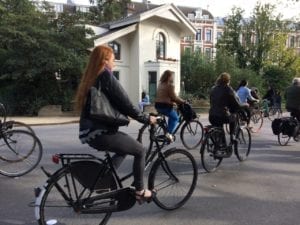Bruce Miller, who has shared details about the Marlborough Golf Club, has a family connection to the historic Barr Colony
Click here for previous posts about Marlborough >
We have not had any new input lately regarding the Marlborough Golf Club; we covered a lot of ground regarding the history of the course in previous posts.
Bruce Miller, who has previously shared interesting details about the Marlborough club, has brought me up to date with his connection to the region of Southwestern Ontario where I now live, having moved with my family to Stratford in 2018. In 2018, we also spent some time in Amsterdam. The photo at this page is from the latter city.

Amsterdam bike scene, August 2018. Jaan Pill photo. I have Witten a series of posts about Amsterdam.
Bruce writes:
I do not recall if I mentioned this to you previously, that my Miller ancestors were early pioneers of Ontario. They settled in Lucan in the early 1800’s, only around 30 minutes from where you reside.
They bred Clydesdale horses and were general store operators. My great grandfather James Miller made 40 trips across the Atlantic to bring horses to Ontario. Can you imagine the challenge of getting them to Lucan?
In 1903, a group of 2600 pioneers from the UK, known as the Barr Colonists, migrated to Canada and were given land grants in Northern Alberta, which became known as Lloydminster, after the Colonist [by the name of Lloyd].
The Miller family joined the group in 1903, and they all headed West via wagon train. The Millers were General store operators, as well as horse breeders, both necessary services which would be required in a new settlement.
My father was 5 years old. They were given land grants North of what would become Lloydminster, however, never used the land, and eventually gave it back to Alberta, which became a Province in 1905. Ironically, the land is where much of the oil fields exist!
My Uncle Archie lived in a tent and befriended the Cree Indians. He learned to speak Cree and was very highly regarded by the Cree nation. Since he spoke Cree, he eventually was very involved in negotiating Cree lands with the CDN and Alberta governments. He was later named a Cree Chief, a major honor never bestowed on non Indians.
There is a famous hockey arena in Lloydminster named the Archie Miller Arena.
Anyway, since you live so close to Lucan, I thought you would enjoy reading a bit of local history.
I’ve continued the conversation:
That’s really interesting: the connection to Lucan; also the connection to the Barr Colonists. One of the many books about Alberta history I have on hand, in connection with a biography I’m writing about a speech therapist who lived in Alberta, speaks about the Barr Colony.
It’s been really interesting to read, just now, about the Barr Colony, in Peoples of Alberta: Portraits of Cultural Diversity (1985). I look forward to reading the book from cover to cover.
The Barr Colony is also discussed in The Prairie West as Promised Land (2007). Again, I look forward to reading the book cover to cover. The fact you have mentioned the Barr Colony provides motivation for me to read the books closely as part of my research for the biography. Thus the story of the Barr Colony remains a source of motivation many years later!
The Cree connection is of much interest also. For the book I’m writing, the history of the Indigenous peoples in the region of Dalum, Alberta, is of particular interest to me. An excerpt from my current draft for the Preface for the biography sets the scene of Einer Boberg’s early years:
This biography concerns the life and times of Einer Boberg, who was born in Drumheller, Alberta, a small town east of the Canadian Rockies, in 1935, and died in Edmonton, Alberta, in 1995. Einer grew up in the small Danish farming community of Dalum, 20 kilometres south of Drumheller; the community was settled by a faction of Danes arriving from the United States [in the early 1900s], who were strongly devoted to music in contrast to another, competing faction, who were more intensely devoted to doctrinal matters.
I’ve been reading many books about Indigenous history including for example: From Treaties to Reserves: The Federal Government and Native Peoples in Territorial Alberta, 1870-1905 (2015) and Lost Harvests: Prairie Indian Reserve Farmers and Government Policy (2019).
For my book project, I draw inspiration from Robert Caro who’s written several impressive biographies over the years. I’m following an approach to writing a biography that closely follows the model for such writing that he outlines in his mini-memoir, Working (2019).
I’ve also been reading extensively about Fort McMurray including Fire Weather (2023; 2024) by John Vaillant.
Bois Franc Road
I’ve also spoken with Bruce about my interest in finding some details about Bois Franc Road. I’ve recently used Google Maps to answer a question from Rhonda Forbes, who has a connection to that part of Montreal:
Bruce has commented:
I have no knowledge of Bois Franc history, other than remembering it was near Canadair.
I remember vividly however, seeing the Sabre jets being test flown out of Canadair. Sometime after WW2, in the late 40’s, Canadair developed and tested a new jet fighter aircraft. From 1950 onward, 1800 Sabre jets were built there. From the back of our home in Snowdon, you could see them tested almost daily , as they headed skyward and then went into steep dives.
I have commented in turn:
I remember the Sabre jets at Canadair. Sometimes a friend and I would ride our bikes to a location where we could watch the jets taking off.

Leave a Reply
Want to join the discussion?Feel free to contribute!